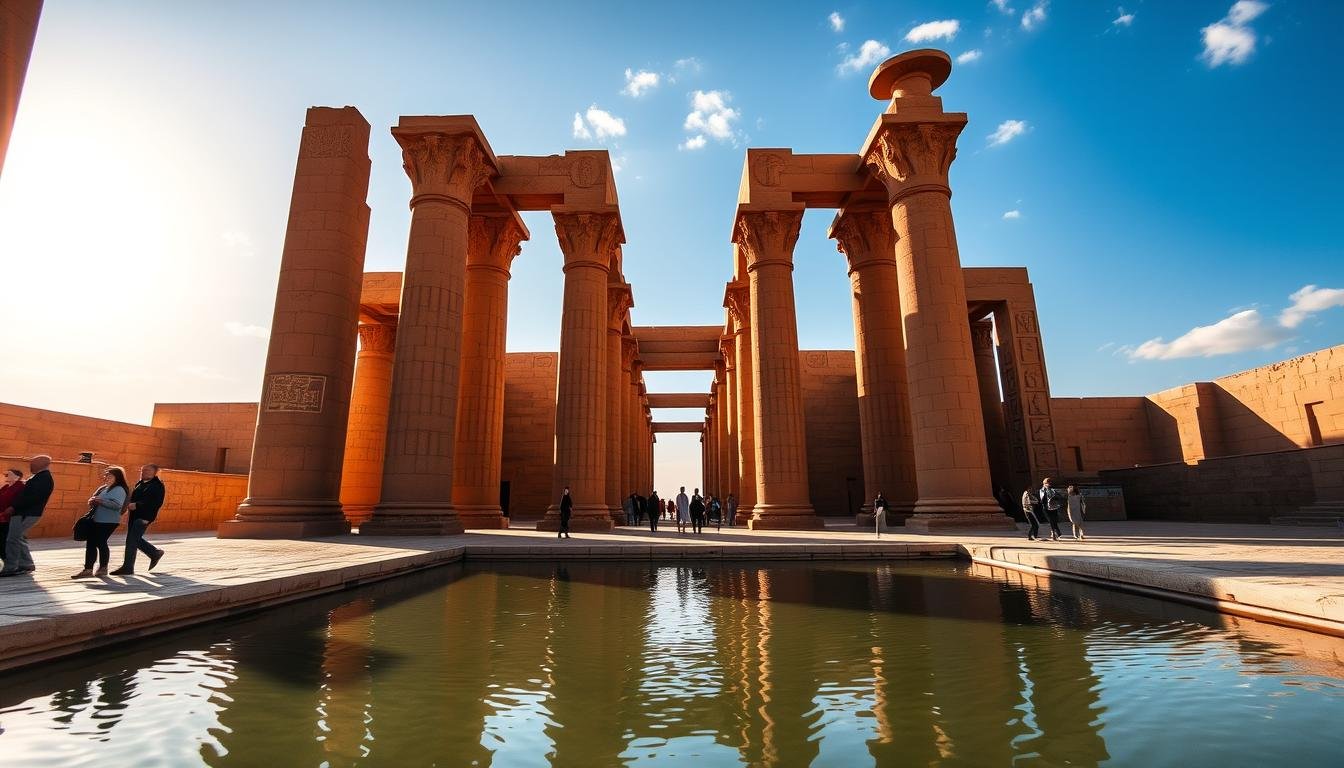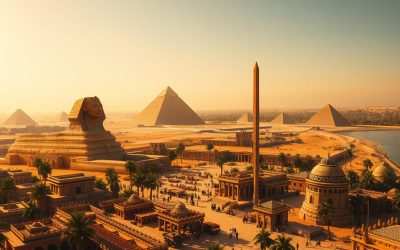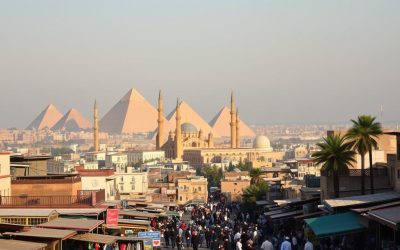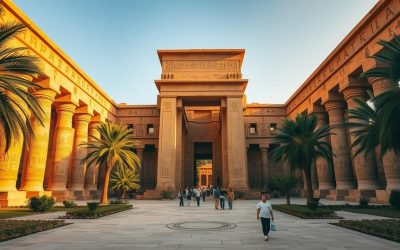Have you ever wondered what it feels like to step into a world where history comes alive? Imagine walking through towering columns, ancient inscriptions, and sacred sites that have stood for thousands of years. Welcome to Karnak, a place where the past meets the present in the heart of Luxor.
This article is your ultimate guide to exploring the wonders of Karnak. From the awe-inspiring Great Hypostyle Hall to the mysterious avenue of sphinxes, you’ll discover the secrets of this ancient site. Whether you’re a history enthusiast or a curious traveler, this guide offers practical tips and fascinating insights to make your visit unforgettable.
Get ready to dive into the rich history of ancient Egyptian civilization. Let’s uncover the stories behind the temples, tombs, and monuments that make Karnak one of the most remarkable places on Earth.
Key Takeaways
- Karnak is the largest human-made temple complex in the world.
- The Great Hypostyle Hall features 134 massive sandstone columns.
- Luxor is home to many ancient Egyptian wonders, including Karnak.
- This guide provides historical facts and practical travel tips.
- Discover hidden details about the avenue of sphinxes and more.
Welcome to Your Journey in Ancient Egypt
Step into a land where time stands still, and every corner whispers tales of a glorious past. This is your invitation to explore the wonders of ancient Egypt, a place where history and culture come alive in breathtaking detail.
From the towering columns of Luxor Temple to the sprawling grandeur of Karnak Temple, you’ll uncover the secrets of a civilization that shaped the world. These iconic sites are more than just monuments—they’re gateways to understanding the traditions and artistry of a bygone era.
Your journey will take you to the legendary Valley of the Kings, where pharaohs were laid to rest in elaborate tombs. Along the banks of the Nile, you’ll discover the stories behind majestic statues and intricate temple architecture. Each step reveals a new layer of history, waiting to be explored.
But this isn’t just a guide to ancient sites. You’ll also gain cultural insights and practical tips to make your trip seamless. Whether you’re navigating the bustling streets of Cairo or marveling at the serene beauty of the Nile, we’ve got you covered.
“Egypt is not just a place; it’s an experience that stays with you forever.”
Here’s what you can expect:
- Insider hints to explore sacred sites beyond the guidebook.
- Practical advice for visiting landmarks in Cairo and Luxor.
- A blend of ancient mystique and modern travel convenience.
Get ready to immerse yourself in a world where the past meets the present. Your adventure in ancient Egypt starts here.
Karnak, Egypt: Best Things to Do – Top Picks
Immerse yourself in a world where ancient columns and sacred sanctuaries tell stories of a civilization long past. The Karnak Temple complex is a treasure trove of history, offering a glimpse into the grandeur of ancient Egyptian architecture. This section dives into the must-see attractions and activities that make this site unforgettable.
One of the highlights is the Great Hypostyle Hall, a breathtaking space with 134 towering columns. Each column is intricately carved, showcasing the artistry of a bygone era. Walking through this hall, you’ll feel the weight of history surrounding you.
Another must-see is the avenue of sphinxes, a pathway lined with statues that once connected Luxor Temple to Karnak. This sacred route was used for religious processions, adding a layer of cultural significance to your visit.
“The temple is not just a place; it’s a journey through time.”
Here are some practical tips to enhance your experience:
- Arrive early to avoid crowds and enjoy the serene atmosphere.
- Wear comfortable shoes, as the complex is vast and requires a lot of walking.
- Consider hiring a guide to gain deeper insights into the site’s history.
From the towering columns to the intricate carvings, every corner of the Karnak Temple complex tells a story. Whether you’re a history buff or a casual traveler, this site offers something for everyone. Get ready to explore one of the most remarkable places on Earth.
Exploring the Colossal Karnak Temple Complex
Step into a world where ancient grandeur meets timeless history. The Karnak Temple complex is a sprawling marvel, covering over 200 acres. It’s a place where every stone tells a story, and every corner reveals a piece of ancient Egyptian culture.
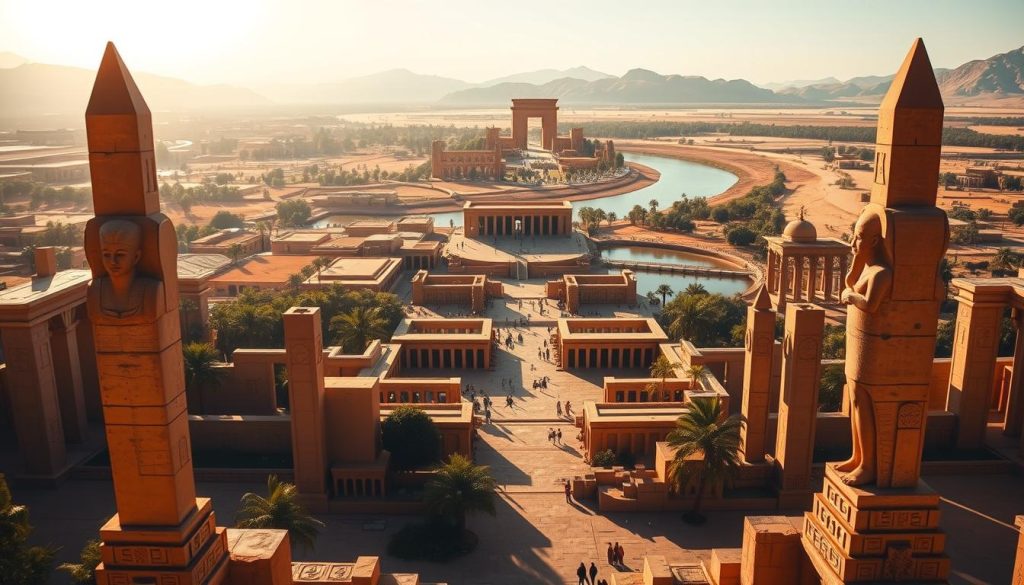
This vast site was built over 2,000 years, starting around 2055 BC. It’s not just a temple; it’s a testament to the ingenuity and devotion of a civilization that shaped the world. From towering columns to sacred pathways, the complex offers a journey through time.
Discover the Great Hypostyle Hall
One of the most breathtaking features is the Great Hypostyle Hall. With 134 massive sandstone columns, some reaching 75 feet high, it’s a sight to behold. The intricate carvings on each column showcase the artistry of ancient Egypt.
Walking through this hall, you’ll feel the weight of history. The sheer scale of the structure is awe-inspiring. It’s a must-see for anyone visiting Luxor.
Strolling Along the Avenue of Sphinxes
Another iconic feature is the avenue of sphinxes. This pathway, lined with statues, once connected Luxor Temple to Karnak. It was used for religious processions, adding cultural significance to your visit.
Strolling along this avenue, you’ll feel transported back in time. The statues, with their human heads and lion bodies, are a symbol of protection and power.
| Feature | Details |
|---|---|
| Great Hypostyle Hall | 134 columns, up to 75 feet high |
| Avenue of Sphinxes | Pathway connecting Luxor Temple to Karnak |
| Sacred Lake | Panoramic views, used for rituals |
For the best experience, visit early in the day to avoid crowds and enjoy the natural lighting. Wear comfortable shoes, as the complex is vast and requires a lot of walking. Consider hiring a guide to gain deeper insights into the site’s history.
Unveiling the History of Luxor Temples
Ever imagined how sunlight transforms ancient stones into a living story? The Luxor Temple is a place where time seems to pause, revealing its secrets in the shifting light of day and night. From the golden glow of sunrise to the enchanting illumination of moonlight, this iconic site offers a unique experience at every hour.
Daytime Splendor
During the day, the temple’s grandeur is on full display. Sunlight dances across the intricate carvings and towering columns, highlighting the artistry of ancient Egyptian craftsmanship. The play of light and shadow brings the stonework to life, making it a photographer’s dream.
Visiting in the morning allows you to avoid the midday heat and crowds. The soft light of dawn enhances the temple’s details, offering a serene atmosphere for exploration.
Nighttime Magic
As the sun sets, the temple undergoes a magical transformation. The Luxor Temple is bathed in soft, golden light, creating an ethereal ambiance. The illuminated pathways and statues evoke a sense of wonder, transporting you back in time.
Night visits are perfect for capturing the temple’s mystical beauty. The cooler temperatures and fewer visitors make it an ideal time to soak in the history and atmosphere.
“The temple’s glow at night is like stepping into a dream—a moment frozen in time.”
Practical Tips for Your Visit
- Plan your visit during sunrise or sunset for the best lighting and fewer crowds.
- Wear comfortable shoes, as the temple grounds require a lot of walking.
- Consider hiring a guide to gain deeper insights into the temple’s history and significance.
Whether you visit by day or night, the Luxor Temple promises an unforgettable journey through ancient Egypt. Timing your visit wisely ensures you’ll witness the full beauty of this timeless wonder.
Diving into Ancient Egyptian Archaeology
Delve into the hidden corners of history where art and ritual intertwine. The Karnak Temple complex is not just about its grandeur; it’s a treasure trove of archaeological wonders waiting to be explored. From lesser-known sanctuaries to intricate carvings, this section uncovers the stories behind the stones.
Temple of Khonsu Marvels
One of the hidden gems within the complex is the Temple of Khonsu. Dedicated to the moon god, this sanctuary is a masterpiece of ancient Egyptian architecture. Its walls are adorned with detailed reliefs and hieroglyphs, many of which have retained their original colors thanks to meticulous restoration efforts.
As you walk through the temple, you’ll notice the intricate carvings that depict religious rituals and celestial events. These details offer a glimpse into the spiritual life of the ancient Egyptians, making it a must-see for history enthusiasts.
Insights into Thutmose III’s Festival Hall
Another fascinating site is the Festival Hall of Thutmose III. Built to celebrate the king’s military victories, this hall was a hub of ancient celebrations. Its unique design features towering columns and a ceiling adorned with stars, symbolizing the heavens.
Recent restoration efforts have uncovered vibrant paintings and inscriptions that were hidden for centuries. These discoveries provide valuable insights into the history and culture of the New Kingdom period.
“Every stone tells a story, and every carving reveals a piece of the past.”
| Feature | Details |
|---|---|
| Temple of Khonsu | Dedicated to the moon god, preserved decorative details |
| Thutmose III’s Festival Hall | Celebrated military victories, restored ceiling paintings |
| Restoration Efforts | Uncovered original colors and inscriptions |
For the best experience, consider hiring a guide to explain the significance of these sites. Arrive early to enjoy the serene atmosphere and avoid crowds. Wear comfortable shoes, as these areas require a lot of walking.
Exploring these lesser-known sections of the complex offers a deeper understanding of ancient Egyptian culture. From art to ritual, every corner reveals a new layer of history, making your visit truly unforgettable.
Discovering the Open-Air Museum at Karnak
Step into a serene outdoor gallery where history is etched in stone. The Open-Air Museum at Karnak Temple is a peaceful retreat, offering a chance to explore lesser-known treasures of ancient Egypt. This quiet space is perfect for reflective exploration, away from the bustling crowds.
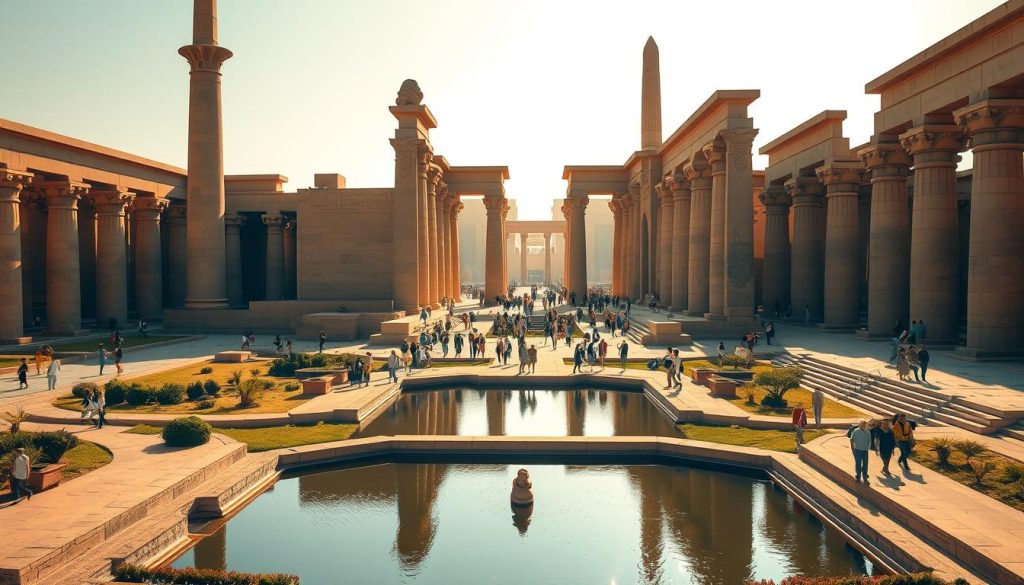
White Chapel of Senusret I
One of the highlights is the White Chapel, built by Pharaoh Senusret I. This chapel served as a barque shrine, a place where sacred boats were stored during religious ceremonies. Its limestone walls are adorned with intricate carvings, showcasing the artistry of the Middle Kingdom.
Rediscovered in the early 20th century, the chapel was reconstructed using original blocks found scattered across the site. Today, it stands as a testament to the craftsmanship and devotion of ancient Egyptian builders.
Red Chapel of Hatshepsut
Another gem is the Red Chapel, commissioned by Queen Hatshepsut. Made of red quartzite, this chapel was dedicated to the god Amun. Its walls are covered with detailed reliefs, depicting scenes of religious rituals and royal ceremonies.
After being dismantled and reused in later constructions, the chapel was painstakingly reassembled by archaeologists. Its rediscovery provides valuable insights into the reign of one of Egypt’s most famous female pharaohs.
“The Open-Air Museum is a place where art, religion, and history converge, offering a deeper understanding of ancient civilizations.”
| Feature | Details |
|---|---|
| White Chapel | Barque shrine, intricate carvings, Middle Kingdom |
| Red Chapel | Red quartzite, dedicated to Amun, Queen Hatshepsut |
| Rediscovery | Reconstructed using original blocks, 20th century |
For the best experience, visit early in the day to enjoy the tranquil atmosphere. Bring a camera to capture the intricate details of the carvings. Consider hiring a guide to gain deeper insights into the history and significance of these chapels.
This open-air sanctuary invites you to appreciate the fusion of art, religion, and history. Whether you’re a history enthusiast or a casual traveler, this lesser-known part of the complex offers a unique and enriching experience.
Experiencing the Sacred Lake and Nile Views
Imagine standing by a tranquil lake where ancient rituals once took place. The Sacred Lake at the Karnak Temple complex is a place of profound serenity and historical significance. This water source played a vital role in purification ceremonies, offering a glimpse into the spiritual practices of ancient Egypt.
As you stroll along the lake’s edge, you’ll feel a deep connection to the past. The water reflects the towering columns and intricate stonework of the surrounding temple, creating a harmonious blend of nature and architecture. It’s a perfect spot for quiet reflection and photography.
Sacred Lake Rituals and Relaxation
The lake was more than just a water source; it was a place of spiritual renewal. Priests used its waters for purification rituals, preparing themselves for sacred ceremonies. Today, the lake remains a peaceful retreat, inviting you to pause and soak in its timeless beauty.
Nearby, the Nile River offers stunning views that complement the lake’s tranquility. From the temple grounds, you can see the river winding its way through the city, a reminder of its enduring role in history and daily life.
“The Sacred Lake is a place where the past whispers through the ripples of water, offering a moment of peace in a bustling world.”
Here are some tips to enhance your visit:
- Visit early in the morning or late afternoon to avoid harsh sunlight and enjoy softer lighting for photos.
- Wear comfortable shoes, as the area around the lake requires walking on uneven surfaces.
- Consider staying at a nearby hotel with views of the Nile for a complete experience.
The Sacred Lake is more than a historical site; it’s a place where you can embrace the blend of ancient Egyptian culture and natural beauty. Whether you’re a history enthusiast or simply seeking a moment of calm, this serene space offers something truly special.
Visiting the Egyptian-Hittite Peace Treaty Inscription
What if you could witness the first peace treaty in history carved into stone? At the Karnak Temple, you’ll find the Egyptian-Hittite Peace Treaty inscription, a remarkable piece of ancient Egyptian diplomacy. Dating back to 1259 BC, this treaty is one of the oldest recorded agreements between two civilizations.
Located on the outer wall of the Cachette Court, the inscription tells a story of peace and negotiation. The hieroglyphs detail the terms of the treaty, showcasing the artistry and precision of ancient Egyptian craftsmanship. It’s a testament to the enduring power of diplomacy.
To locate this inscription, look for the detailed carvings among the countless wall decorations. A guide can help you spot the subtle details and explain the historical context. Visiting early in the morning or late afternoon ensures a quieter experience and better lighting for viewing.
“This inscription is more than a relic; it’s a timeless reminder of the importance of peace.”
Here are some tips for your visit:
- Bring a guidebook or hire a guide to fully understand the inscription’s significance.
- Visit during off-peak hours to avoid crowds and enjoy a more reflective experience.
- Take your time to appreciate the blend of art, history, and cultural symbolism.
The Egyptian-Hittite Peace Treaty inscription is a must-see for anyone interested in ancient Egypt. It’s a place where history comes alive, offering a unique glimpse into the past. Whether you’re a history buff or a casual traveler, this inscription will leave a lasting impression.
Touring the Valley of the Kings and Hatshepsut Temple
Journey into a realm where royal legacies and architectural marvels stand as timeless testaments to ancient ingenuity. The Valley of the Kings and Hatshepsut Temple are two of Luxor’s most iconic sites, offering a glimpse into the grandeur of ancient Egyptian civilization. Whether you’re drawn to the mysteries of royal tombs or the innovative design of temples, this dual exploration promises an unforgettable experience.
Highlights of King Tut’s Tomb
One of the most famous discoveries in the Valley of the Kings is the tomb of King Tutankhamun. Known as KV62, this tomb is a treasure trove of artifacts and intricate frescoes. The burial chamber’s walls are adorned with vivid paintings depicting the young pharaoh’s journey to the afterlife.
Despite its small size compared to other tombs, King Tut’s tomb is a must-see. The artifacts, including the iconic golden mask, offer a rare glimpse into the opulence of ancient Egyptian royalty. To avoid crowds, visit early in the morning or late afternoon.
Architectural Wonders at Hatshepsut Temple
The Mortuary Temple of Hatshepsut is a masterpiece of ancient Egyptian architecture. Built into the limestone cliffs, this temple is a striking blend of natural and man-made beauty. Its terraced design and towering columns make it one of the most unique structures in Luxor.
Hatshepsut’s temple was dedicated to the god Amun and served as a place of worship and celebration. The reliefs on its walls depict the queen’s achievements, including her famous expedition to the land of Punt. Take your time to explore the temple’s courtyards and sanctuaries, each with its own story to tell.
“The Valley of the Kings and Hatshepsut Temple are not just sites; they are gateways to understanding the lives and beliefs of ancient civilizations.”
| Feature | Details |
|---|---|
| King Tut’s Tomb | KV62, golden mask, frescoes |
| Hatshepsut Temple | Terraced design, limestone cliffs, Amun worship |
| Best Time to Visit | Early morning or late afternoon |
To make the most of your visit, consider hiring a guide who can provide deeper insights into the history and significance of these sites. Wear comfortable shoes, as both locations require a lot of walking. Combine your trip with a stay at a nearby hotel for a seamless experience.
Exploring the Valley of the Kings and Hatshepsut Temple is a journey through time. From royal tombs to architectural wonders, these sites offer a fascinating look into the past. Whether you’re a history enthusiast or a curious traveler, this dual exploration is sure to leave a lasting impression.
Cultural Tips for Navigating Luxor
Navigating the cultural nuances of Luxor can make your visit more enriching and respectful. This vibrant city is a blend of ancient wonders and modern life, and understanding local customs will enhance your experience. From dressing appropriately to interacting with locals, these tips will help you explore with confidence.
What to Wear & Local Etiquette
When visiting temples and sacred sites, dressing modestly is key. Opt for clothing that covers your shoulders and knees. Lightweight, breathable fabrics are ideal for the warm climate. Avoid tight or revealing outfits to show respect for local norms.
Interacting with locals is a highlight of any trip. A simple greeting in Arabic, like “As-salamu alaykum,” can go a long way. Be polite when bargaining with vendors, and always ask before taking photos of people. These small gestures are appreciated and foster positive connections.
Timing Your Visit
Plan your day to avoid the busiest hours at popular sites. Early mornings or late afternoons are ideal for exploring Luxor Temple and other landmarks. This not only helps you beat the heat but also allows for a more peaceful experience.
When visiting the Nile, consider a felucca ride during sunset for stunning views. Timing your activities thoughtfully ensures you make the most of your trip while respecting local routines.
Practical Tips for a Smooth Experience
- Wear comfortable shoes for walking on uneven surfaces at ancient sites.
- Carry a scarf or shawl to cover up when entering religious spaces.
- Stay hydrated and carry sunscreen, especially during peak daytime hours.
- Hire a local guide to gain deeper insights into the history and culture.
| Tip | Details |
|---|---|
| Dress Modestly | Cover shoulders and knees, especially at temples. |
| Greet Locals | Use simple Arabic phrases to show respect. |
| Timing | Visit early or late to avoid crowds and heat. |
| Local Transport | Use feluccas or horse carriages for a unique experience. |
By following these cultural tips, you’ll not only respect local traditions but also enjoy a more meaningful and memorable visit to Luxor. Whether you’re exploring ancient sanctuaries or strolling along the Nile, these insights will help you navigate the city with ease and confidence.
Planning Your Luxor Itinerary
Planning a trip to Luxor? Here’s how to make the most of your 48 hours in this historic city. From iconic temples to hidden gems, this itinerary ensures you experience the best of ancient Egyptian culture while maximizing your time.
Optimizing a 48-Hour Visit
Start your first day early at the Karnak Temple complex. Arriving before the crowds allows you to appreciate the towering columns and intricate carvings in peace. Spend 2-3 hours exploring the Great Hypostyle Hall and the Sacred Lake.
Next, head to the Luxor Temple, just a short distance away. This site is equally stunning during the day, with its grand statues and detailed reliefs. Allocate 1-2 hours here before breaking for lunch at a local café.
In the afternoon, visit the Luxor Museum to see artifacts from King Tut’s tomb and other significant finds. Wrap up your day with a sunset felucca ride on the Nile, offering breathtaking views of the city.
Must-See Sights and Hidden Gems
On your second day, explore the West Bank. Begin at the Valley of the Kings, where you can visit 3 tombs included with your ticket. Don’t miss King Tutankhamun’s tomb for a glimpse into ancient Egyptian royalty.
Next, head to the Mortuary Temple of Hatshepsut, a masterpiece of ancient architecture. Its terraced design and cliffside location make it a unique stop. Spend 1-2 hours here before visiting the lesser-known Medinet Habu, dedicated to the god Amon.
End your trip with a visit to the Colossi of Memnon, two massive statues that guard the Temple of Amenhotep III. This is a quick but memorable stop before heading back to your hotel.
“Luxor is a place where every corner tells a story. With careful planning, you can uncover its secrets in just 48 hours.”
Here are some tips to optimize your visit:
- Start early to avoid crowds and make the most of your day.
- Hire a guide for deeper insights into the history of each site.
- Wear comfortable shoes, as you’ll be walking on uneven surfaces.
- Carry water and sunscreen, especially during peak daytime hours.
This itinerary balances iconic landmarks with hidden treasures, ensuring a rich and fulfilling experience in Luxor. Whether you’re a history enthusiast or a casual traveler, this plan will help you make the most of your time in this incredible city.
Where to Find the Best Local Dining and Accommodation
When it comes to exploring Luxor, finding the perfect place to stay and dine can elevate your travel experience. Whether you’re looking for luxury or authenticity, this vibrant city offers something for everyone. From high-end hotels with stunning views of the Nile to bustling street food markets, your journey will be as memorable as the ancient sites you visit.
Comparing Luxury Hotels: Sofitel vs. Steigenberger
For those seeking comfort and elegance, Luxor boasts some of the finest hotels in the region. The Sofitel Winter Palace and Steigenberger Nile Palace are two top-rated options, each offering unique amenities and exceptional service.
The Sofitel Winter Palace is a historic gem, blending colonial charm with modern luxury. Guests can enjoy a gourmet breakfast, a serene pool, and breathtaking views of the Nile. Its proximity to the Luxor Temple (just 0.5 km away) makes it a convenient choice for history enthusiasts.
On the other hand, the Steigenberger Nile Palace offers a more contemporary vibe. With spacious rooms, a wellness spa, and a rooftop terrace overlooking the river, it’s perfect for travelers seeking relaxation. Located just 0.4 km from the Luxor Temple, it’s equally accessible to major attractions.
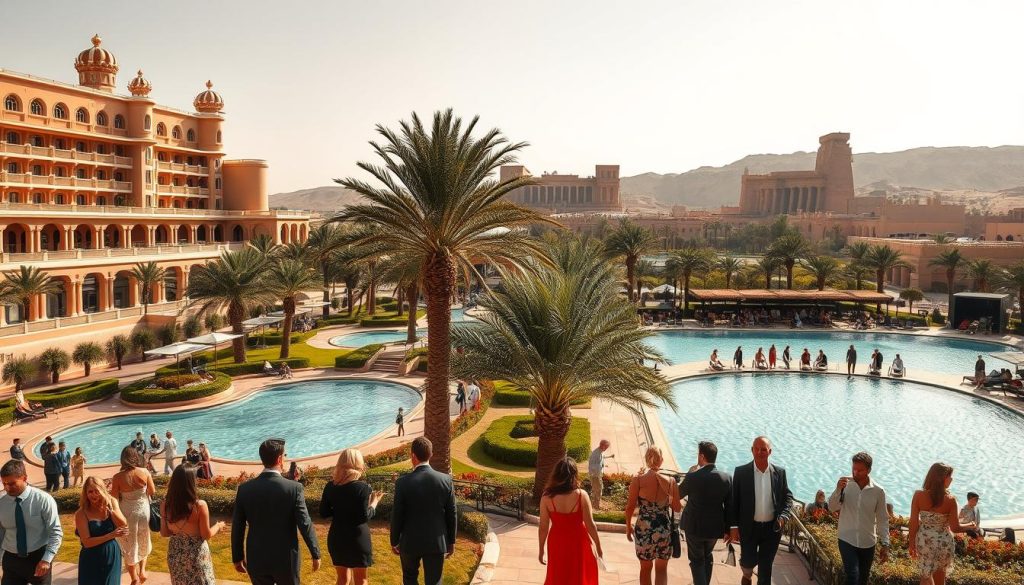
| Feature | Sofitel Winter Palace | Steigenberger Nile Palace |
|---|---|---|
| Distance to Luxor Temple | 0.5 km | 0.4 km |
| Average Nightly Rate | $240 | $195 |
| Rating | 9.2/10 | 9.0/10 |
| Standout Amenities | Historic charm, Nile views | Rooftop terrace, wellness spa |
Savoring Local Flavors and Street Cuisine
No visit to Luxor is complete without indulging in its rich culinary traditions. From upscale restaurants to humble street vendors, the city offers a feast for your senses.
For a formal dining experience, try 1886 Restaurant at the Sofitel Winter Palace. It’s known for its gourmet dishes and elegant ambiance. If you prefer something more casual, head to the local markets where you can savor Egyptian staples like koshari, falafel, and freshly baked bread.
Street food is a must-try. Vendors along the Nile offer delicious treats like taameya (Egyptian falafel) and grilled meats. Don’t miss the chance to try sugarcane juice or hibiscus tea for a refreshing break.
“Food is the heart of any culture, and in Luxor, every bite tells a story.”
Here are some tips for enjoying local cuisine:
- Visit busy stalls—popular spots often mean fresh and flavorful food.
- Ask locals for recommendations to discover hidden gems.
- Try traditional dishes like molokhia or stuffed pigeon for a unique experience.
Whether you’re staying in a luxurious hotel or exploring the streets, Luxor promises an unforgettable blend of comfort and culture. Book your accommodations early, especially during peak seasons, to secure the best deals and enjoy your stay to the fullest.
Insider Tips and Budget Travel Advice in Egypt
Exploring ancient wonders doesn’t have to break the bank—here’s how to experience the magic of Egypt on a budget. With a little planning, you can enjoy the rich history and culture without overspending. From affordable transportation to hidden gems, these tips will help you make the most of your travel.
Start by avoiding tourist traps. Popular sites like the Valley of the Kings and Karnak Temple are must-sees, but entrance fees can add up. Consider purchasing a combo ticket or visiting during off-peak hours to save money. Many attractions, like the Luxor Museum, offer student discounts, so bring your ID.
Transportation doesn’t have to be expensive. In Cairo, Uber is a cost-effective way to get around, with rides from Giza to the airport costing around 100 LE ($7.70). In Luxor, felucca rides on the Nile are both affordable and scenic. For longer distances, consider taking a sleeper train, which is less crowded and budget-friendly.
When it comes to dining, skip the high-end restaurants and head to local markets. A bowl of koshari, a traditional dish, costs around 35 LE ($2.70). Street food like taameya (Egyptian falafel) is not only delicious but also easy on the wallet. Don’t forget to try sugarcane juice or hibiscus tea for a refreshing treat.
“Traveling on a budget doesn’t mean missing out—it’s about finding the hidden gems that make your trip unforgettable.”
Accommodations can also be affordable if you book wisely. Look for guesthouses or budget hotels near major attractions. Many offer clean, comfortable rooms at a fraction of the cost of luxury hotels. Booking in advance can also help you secure the best deals.
Here are some free or low-cost attractions that still deliver a powerful history lesson:
- The Colossi of Memnon—two massive statues guarding the Temple of Amenhotep III.
- Islamic and Coptic Cairo—explore over 1,000 years of architectural history.
- The Nile Corniche—a perfect spot for a scenic walk or sunset view.
| Cost-Saving Strategy | Details |
|---|---|
| Transportation | Use Uber or feluccas for affordable travel. |
| Dining | Opt for street food and local markets. |
| Accommodation | Book budget hotels or guesthouses in advance. |
| Attractions | Visit free sites like the Colossi of Memnon. |
By following these tips, you can enjoy a luxurious experience even on a tight budget. Remember, travel is about the journey, not the price tag. With careful planning, you’ll uncover the true essence of Egypt—its history, culture, and timeless beauty.
Travel Essentials and Practical Advice for Your Visit
Preparing for your trip to Egypt? Here’s everything you need to know to make your journey smooth and enjoyable. From handling local currency to navigating transportation, these tips will help you feel confident and well-prepared.
Currency and Exchange Rates
The official currency is the Egyptian pound (EGP). You can exchange money at banks, airports, or authorized exchange offices. Check rates online before your trip to get the best deal. ATMs are widely available in major cities like Luxor and Cairo.
Carry small bills for tipping, as it’s a common practice in Egypt. Service workers rely on gratuities, so having EGP 5 or 10 notes is helpful. For larger purchases, credit cards are accepted in most hotels and restaurants.
Transportation Options
Getting around Egypt is easier than you might think. In Cairo, ride-sharing apps like Uber and Careem are affordable and convenient. For longer distances, consider taking a sleeper train or bus. The train from Cairo to Luxor costs around $25 and takes about 10 hours.
If you’re exploring Luxor, hiring a private driver is a great option. It allows you to visit multiple sites in one day without worrying about directions. For a unique experience, take a felucca ride on the Nile during sunset.
Safety Tips for Travelers
Egypt is generally safe for tourists, but it’s important to stay vigilant. Keep your belongings secure, especially in crowded areas. Avoid displaying expensive items like cameras or jewelry in public.
When visiting temples or archaeological sites, follow local guidelines. Wear comfortable shoes and stay hydrated, especially during the hotter months. If you’re traveling alone, let someone know your itinerary.
“A well-prepared traveler is a confident traveler. Take the time to plan, and your trip will be unforgettable.”
| Travel Essential | Details |
|---|---|
| Currency | Egyptian pound (EGP), exchange at banks or ATMs |
| Transportation | Uber, Careem, sleeper trains, private drivers |
| Safety | Secure belongings, follow local guidelines |
| Tipping | Carry small bills for gratuities |
By following these tips, you’ll be ready to explore Egypt with ease. Whether you’re marveling at the Luxor Temple or cruising the Nile, these essentials ensure a seamless and enjoyable experience.
Diverse Attractions: From Karnak to the Nile
From towering ancient temples to serene river views, Egypt offers a blend of history and modern comforts. Whether you’re exploring the grandeur of Karnak or relaxing along the Nile, this destination promises a rich and varied experience.
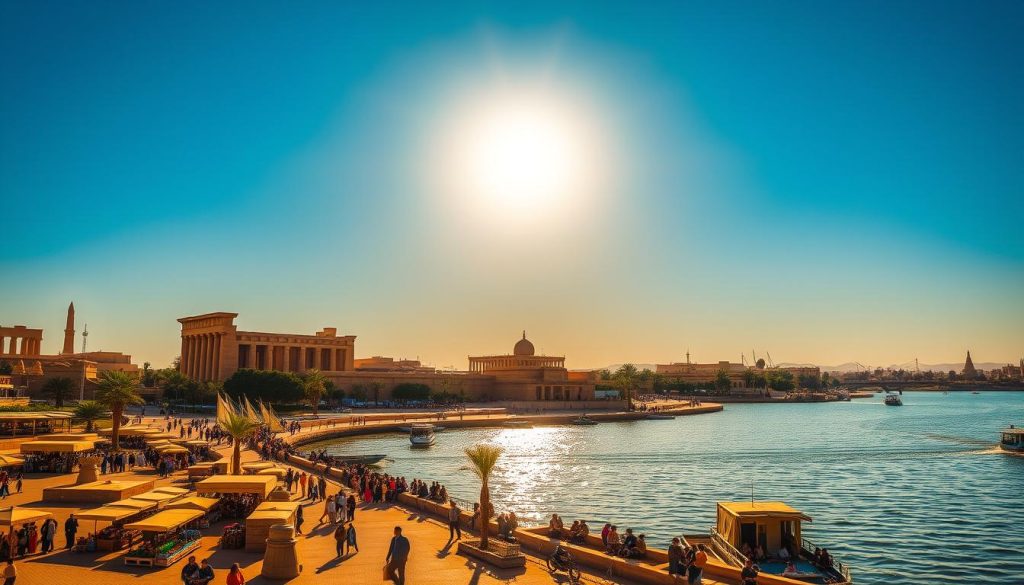
Mixing History, Culture, and Modern Comforts
In Luxor, ancient wonders coexist with contemporary amenities. The Karnak Temple complex, with its towering columns and intricate carvings, is just a short distance from modern hotels and bustling markets. This seamless blend allows you to immerse yourself in history while enjoying the comforts of today.
Along the Nile, you’ll find a mix of cultural and relaxing experiences. Take a felucca ride at sunset or enjoy a meal at a riverside café. These moments offer a chance to reflect on the day’s adventures while soaking in the beauty of the city.
“Egypt is a place where the past and present harmoniously coexist, offering something for every traveler.”
Here are some tips for exploring these diverse attractions:
- Start your day early to visit popular sites like the Luxor Temple before the crowds arrive.
- Balance sightseeing with relaxation by spending afternoons along the Nile or at a local café.
- Consider hiring a guide to gain deeper insights into the history and significance of each site.
For those interested in hidden gems, the Open-Air Museum at Karnak offers a quieter, reflective experience. Here, you can explore lesser-known treasures like the White Chapel and Red Chapel, each with its own unique story.
Planning a day trip? Combine visits to the Valley of the Kings and the Mortuary Temple of Hatshepsut for a full day of exploration. These sites, though steeped in history, are easily accessible and offer a glimpse into the lives of ancient Egyptian royalty.
Whether you’re marveling at the grandeur of Karnak or enjoying the tranquility of the Nile, Egypt’s diverse attractions ensure a memorable journey. With careful planning, you can experience the best of both worlds—history and modern comfort.
Conclusion
Your journey through Luxor’s ancient wonders is just the beginning of an unforgettable adventure. From the towering columns of its grand temples to the serene views along the Nile, every moment is steeped in history and culture.
This guide has offered a blend of awe-inspiring insights and practical tips to help you explore with confidence. Whether you’re marveling at the intricate carvings of the Luxor Temple or uncovering the secrets of the Valley of the Kings, each site tells a story that brings the past to life.
With careful planning and local insights, your travel experience can be both enriching and seamless. Create your personalized itinerary, balancing iconic landmarks with hidden gems, and immerse yourself in the timeless beauty of this ancient city.
Your adventure is just beginning. Pack your curiosity, embrace the blend of ancient Egyptian legacy and modern comforts, and prepare for a journey that will stay with you forever. Thank you for reading, and may your exploration be as unforgettable as the stories you’ll uncover.
The above is subject to change.
Check back often to TRAVEL.COM for the latest travel tips and deals.
Here are some Tours & Sightseeing suggestions that might pique your interests!
